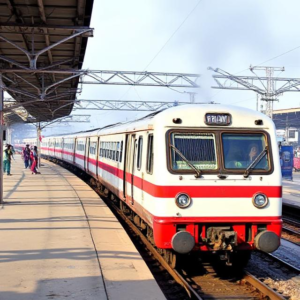Challenges in Railway Land Acquisition: Easy Explanation
Railway land acquisition is an important step when building new railway lines or projects. It involves the process of obtaining land to build railways, stations, tracks, and other related infrastructure. However, this process comes with several challenges, especially because land is often owned by private individuals, communities, or even the government itself. Let’s look at some of the main issues and government policies on land acquisition for railway projects.

1. Issues Faced in Acquiring Land for New Rail Projects
a. Displacement of People
- Landowners and residents living on the land needed for railway projects may be displaced. This means they have to move from their homes, farms, or businesses to make space for the railway.
- Emotional and social impact: People often have emotional attachments to their land and homes, making it difficult for them to accept relocation. There can also be a disruption in their livelihood if they depend on the land for farming or business.
b. Legal and Ownership Disputes
- In many cases, the ownership of the land is not clear, and there may be legal disputes between different people or entities claiming the land. This makes the process of acquiring land slow and complicated.
- Multiple stakeholders: Sometimes, the land may have multiple owners, or there may be competing claims, which leads to disagreements over compensation and usage rights.
c. Environmental Concerns
- Some land required for railway projects may be in forest areas or ecologically sensitive zones. Acquiring such land can have a negative impact on the environment, such as deforestation, destruction of habitats, or pollution.
- Environmental activists and local communities might resist land acquisition if they believe it will harm nature or wildlife.
d. Opposition from Local Communities
- Local communities, especially in rural areas, may not always agree with land acquisition if they fear they will not be compensated fairly, or they may be concerned about the long-term impact of the railway on their environment and livelihood.
- Some people may protest against the acquisition, which can lead to delays and even violence in some cases.
e. Cost and Delays
- Land prices can vary significantly depending on location. In urban areas, where land is expensive, the cost of acquiring land can be high, putting pressure on the project’s budget.
- Due to legal issues, opposition, and other factors, the process of acquiring land often takes a long time, causing delays in the development of the railway project.
2. Government Policies on Land Acquisition for Railway Projects
To overcome these challenges, the government has put in place various policies and laws to guide land acquisition for railway projects. These policies are aimed at balancing the needs of development and the rights of landowners and communities.
a. The Land Acquisition Act (2013)
- In India, the Right to Fair Compensation and Transparency in Land Acquisition, Rehabilitation, and Resettlement Act, 2013 (commonly called the Land Acquisition Act) provides the legal framework for acquiring land for public purposes, including for railways.
- The law ensures that landowners are fairly compensated for their land, and it provides provisions for rehabilitation and resettlement of those displaced by the project.
- The act also ensures that the government consults with the local communities and provides them with opportunities to voice their concerns before land acquisition happens.
b. Compensation for Landowners
- Under the Land Acquisition Act, compensation is given to landowners based on the market value of the land, and in some cases, additional compensation is provided for displacement and loss of livelihood.
- The government tries to offer a fair price for the land, and in some cases, land-for-land compensation may be given to those who are displaced.
c. Focus on Rehabilitation and Resettlement
- To minimize the impact of displacement, the government provides rehabilitation schemes that offer alternative housing and livelihood support for people who lose their homes and businesses due to land acquisition.
- Special programs help people re-establish themselves by offering them new plots of land or support to set up their businesses again.
d. Fast-Tracking Land Acquisition for Important Projects
- To speed up the process, the government sometimes uses special provisions for acquiring land for projects that are considered of national importance, like railways. This can involve streamlining legal processes and expediting approvals.
- In certain cases, the government may issue public notices to inform people about the land acquisition, and if no objections are raised within a specific period, the acquisition process moves forward more quickly.
e. Public Consultation and Consent
- As per the law, the government is required to consult with local communities and stakeholders before acquiring land. This is done to ensure that people’s concerns are addressed.
- If the land being acquired is used for agriculture or is part of tribal areas, the government must get consent from the people who are affected by the project. This helps ensure the process is transparent and fair.
f. Focus on Environmental Protection
- For projects that affect environmentally sensitive areas, the government has environmental guidelines in place to minimize harm. For example, Environmental Impact Assessments (EIAs) are carried out before acquiring land in forested or protected areas.
- The aim is to ensure that sustainable development practices are followed, and damage to nature is minimized.
3. Conclusion
Railway land acquisition is a complex process due to issues like displacement, legal disputes, environmental concerns, and community opposition. However, the government has put policies in place to address these challenges, ensuring that landowners are fairly compensated, that rehabilitation is provided for displaced people, and that environmental protection is considered.
By improving these policies and focusing on community engagement, Indian Railways can overcome the challenges of land acquisition and build a more efficient and inclusive railway network for the future.
Keywords: Indian Railway, Railway











